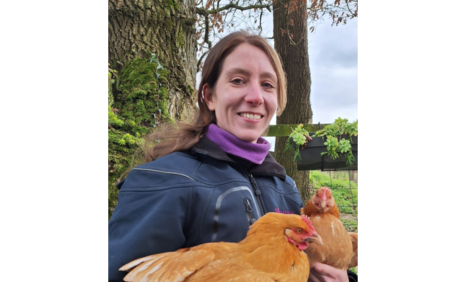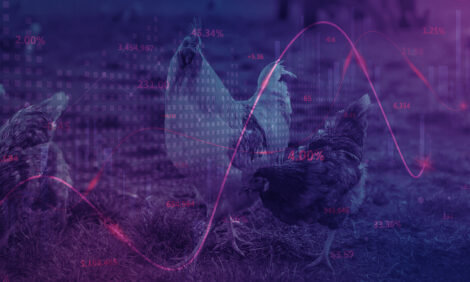



Control of Poultry Pests
By Ralph E. Williams, Extension Entomologist, Department of Entomology, University of Purdue - Several kinds of flies, beetles, and external parasites are a major concern facing poultry producers. The shift from small farm flocks to larger commercial poultry operations has greatly increased these pest concerns.
The high-density, confined housing systems used in
poultry production today create conditions that favor the
development of manure-breeding flies and beetles associated
with poultry litter accumulations. External parasites
(e.g., northern fowl mite, lice) are also of concern in
confined housing systems.
Important Species - House Fly – Musca domestica
The house fly is considered the major pest species
associated with poultry manure, especially in cagedlayer
operations. Accumulated poultry manure can be
highly suitable for house fly breeding, especially where
general sanitation is poor and when there is excessive
moisture. They prefer manure as a breeding source but
have been found breeding in moist, spilled feeds and
other moist, warm decaying organic matter.
With today’s concern about environmental conditions,
fly control takes on added importance. Flies are
considered environmental pollutants just by their presence.
Fly populations may create a public health nuisance
in nearby communities, resulting in poor community
relations and threats of litigation. Unfortunately, as
urbanization and rural non-farm residences increase,
poultry producers will be faced with growing pressure to
reduce fly populations. Also, flies are suspected of
harboring numerous disease organisms.
The female house fly produces up to six batches of
75 to 200 eggs at 3 to 4 day intervals. Larvae (maggots)
hatch in 12 to 24 hours. The maggots complete their
development in 4 to 7 days and then form into dark
reddish-brown pupae. The pupal stage usually lasts 3 to
4 days, after which adult flies emerge. A complete life
cycle can occur in 7 to 10 days under optimal conditions,
longer in cooler temperatures. Adult flies live an average
3 to 4 weeks.
They are most active during the day at temperatures
above 70°F and become inactive at night and at temperatures
below 45°F. Resting adults can be seen on
ceilings, walls, posts, and other surfaces inside a poultry
house, as well as outside on the building and surrounding
vegetation. Preferred resting places can be detected
by the accumulation of “fly specks,” light colored spots
formed from regurgitation and darker fecal spots. The
effective house fly dispersal range appears to be 1/2 to
2 miles from their preferred breeding sources. This will
vary somewhat with different environmental conditions.
Little House Fly – Fannia sp.
The little house fly is generally smaller than the
house fly and not as common in Indiana. When it does
occur, high populations can develop on poultry farms.
Although this fly may invade homes in nearby residential
areas, it tends to be less annoying in that it does not
readily settle on food or people. Adult males show a
distinctive aimless hovering or circling flight behavior of
long duration within the poultry house or at outside
shaded areas. Females are less active and more often
found near breeding sites.
Because this fly is less tolerant of hot, midsummer
temperatures than the house fly, it often emerges in
large numbers in early spring, declines in midsummer,
and may peak again in late fall. The little house fly prefers
a less moist medium in which to breed than the house fly.
Poultry manure generally is preferred over other media.
Little house fly larvae are quite different that the creamy
white cylindrical house fly larvae. They are brownish red,
flattened, and spiny. The complete life cycle ranges from
18 to 22 days but may be longer depending upon
temperature.
Black Garbage Fly – Hydrotea (Ophyra) aenescens
Black garbage flies (also called "dump flies") can be
found in large numbers in poultry facilities. They are
shiny-black in appearance and a little smaller than
house flies. They prefer moisture manure to breed in
than the house fly. Their life cycle ranges from 14 to 45
days. They will breed throughout the year in poultry
houses.
These flies are generally considered to be beneficial,
especially in enclosed egglayer houses. Black
garbage fly larvae will actually kill house fly larvae and
often dominate the manure habitat when presence,
especially in moist manure. Adult black garbage flies
tend to stay on and around the manure surface in
enclosed facilities. In poultry housing exposed to the
outside, these flies are sometimes considered as nuisance
pests.
Blow Flies – Calliphoridae
Numerous species of blow flies (green or bland bottle flies) may occur in poultry houses. They breed in decaying animal carcasses, dead birds, broken eggs, and wet garbage. Prompt removal of dead birds and rodents , preventing accumulation of broken eggs, and daily cleanup of processing areas is usually sufficient to prevent the build-up of these flies.
Small Dung Fly – Sphaeroceridae
Small dung flies, along with several other small gnats, readily breed in poultry manure and other decaying materials. They can occur in large numbers in poultry operations but generally are not a nuisance on the farm or in nearby communities. Population levels are often higher in spring and late summer.
Further Information
To continue reading this article, click here (PDF)
Source: Department of Entomology - Purdue University - August 2002









